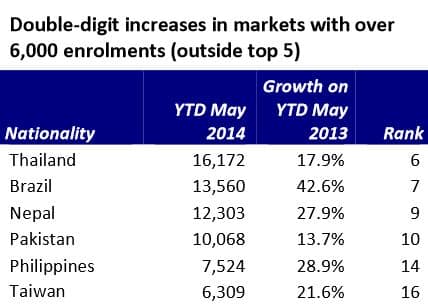Australian enrolment surging in 2014
International education remains Australia’s third-largest export sector and the only non-resource sector in the top five. International education activity contributed an estimated AUS$15 billion to Australia’s economy in 2013 – a 3.8% increase over 2012 but still shy of the previous high of AUS$16.1 billion in 2010. In line with this strengthening economic impact, Australia reversed a three-year enrolment decline in 2013, registering a modest increase of 2.6% in total international student numbers and a much more noticeable bounce (9.3%) in student commencements for the year. It now appears that those promising 2013 results may have been the beginning of a longer-term growth trend. The latest figures from Australian Education International (AEI) for year-to-date through May 2014 paint a convincing picture of a strengthening enrolment base for the country. Some highlights from the AEI data through May 2014 include:
- There were 404,909 full-fee paying international students in Australia on a student visa, representing a 10.1% increase over the same period for 2013. The average growth for the same period over the previous ten years is 4.6%.
- There were 170,269 commencements through May 2014. This adds up to an 18.4% increase over the same period for 2013, and a notable bump over the average annual growth rate of 4.6% recorded over the previous decade.
- Higher education accounted for the largest volumes of both enrolments (49.3%) and commencements (34.7%). Higher education enrolment is up 6.4% YTD May 2014, and commencements grew by 13.6%.
- Vocational Education and Training (VET) enrolments and commencements grew by 5.9% and 18.0% respectively over 2013.
- English Language Intensive Courses for Overseas Students (ELICOS) recorded the largest growth rates over 2013 with a 26.7% jump in enrolment and 25.6% in commencements.
A Department of Education research brief points to the distribution of economic impact by sector:
“In 2013, the higher education sector generated AUS$10.2 billion in export income (68.2% of total on-shore earnings). [VET] was the second largest, generating AUS$2.5 billion in earnings (16.5%). Export income from [English language programmes] was AUS$807 million (5.4%); schools, AUS$579 million (3.9%); and non-award, AUS$545 million (3.6%).”
International student commencements in Australia by sector. Source: Australian Education International
Five source countries accounted for 52.7% of Australia’s international enrolment across all sectors.


“This growth represents the best performance of any year except the peak year of 2009.”
Among the growth areas noted above, ELICOS providers have seen a triple-digit increase in Indian commencements this year. “The number of new Indian students in English language colleges jumped 267% to just under 3,000,” reports The Australian. “But [this is still] well short of the 6,000 Indian commencements for ELICOS in the year to May 2008.” The report goes on to note that a major driver of Indian enrolment growth in 2008 was the packaging of English language courses with vocational programmes, and where “vocational education was a fast-track to permanent residency as a skilled migrant.” This time, however, “it’s higher education packaging,” said Sue Blundell, executive director of English Australia. The shift is attributed in part to the streamlined visa processing (SVP) provisions for university-bound students, a model that the Australian government began to expand in late-2013 to include an initial group of non-university providers. “Under the streamlined student visa processing arrangements, eligible student visa applicants from participating universities and eligible non-university higher education providers are assessed as though they are a lower immigration risk, irrespective of their country of origin,” says the Australian Department of Immigration. Most recently, Education Minister Christopher Pyne announced in May 2014 a further expansion of SVP provisions to include students enrolled in advanced diploma programmes with institutions in the higher education and VET sectors. “Extending SVP arrangements will help capitalise on [enrolment growth trends], reducing red tape and helping to attract further students from overseas,” said the Minister. “The department will write to eligible providers by the second half of 2014 inviting them to participate in the arrangements,” notes a related government statement. “Subject to the legislative change process we anticipate that the extended arrangements will commence by early 2015.”
















